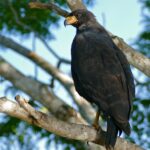The great black hawk (Buteogallus urubitinga) is a large bird of prey found in Central and South America. Its striking black plumage, distinctive white-banded tail, and powerful talons make it a captivating sight for birdwatchers and nature enthusiasts alike. In this comprehensive blog post, we’ll delve into the fascinating world of the great black hawk’s feathers, exploring their unique characteristics, functions, and the role they play in the bird’s survival and adaptation.
Anatomy of the Great Black Hawk Feather
The great black hawk’s feathers are a true marvel of nature. Each feather is composed of a central shaft, called the rachis, with numerous barbs branching off from it. These barbs are further divided into smaller structures called barbules, which interlock with one another to create a smooth, cohesive surface.
The feathers of the great black hawk are primarily black, with the exception of the white basal half of the tail and the white uppertail coverts. This striking contrast in coloration serves a variety of purposes, from camouflage and communication to temperature regulation and flight.
Feather Structure
- Rachis: The central shaft of the feather, providing strength and structure.
- Barbs: The smaller, hair-like structures that branch off from the rachis.
- Barbules: The even smaller structures that interlock with one another, creating the smooth, cohesive surface of the feather.
Feather Coloration
- Black Plumage: The majority of the great black hawk’s body is covered in deep, glossy black feathers, which serve as camouflage in its forested habitat.
- White Tail and Uppertail Coverts: The white basal half of the tail and the white uppertail coverts provide a striking contrast to the black plumage, potentially playing a role in communication and display.
Feather Functions
 Image source: Great Black Hawk by Bernard DUPONT
Image source: Great Black Hawk by Bernard DUPONT
The feathers of the great black hawk serve a variety of essential functions, allowing the bird to thrive in its environment.
Aerodynamics and Flight
The great black hawk’s feathers are specially adapted for efficient flight. The interlocking barbules and the overall shape of the feathers create a smooth, streamlined surface that minimizes air resistance and enables the bird to soar effortlessly through the air.
Insulation and Temperature Regulation
The dense, overlapping feathers of the great black hawk provide excellent insulation, helping the bird maintain a consistent body temperature in the varied climates of its range. The black coloration also plays a role in absorbing or reflecting heat, depending on the bird’s needs.
Communication and Display
The striking black and white plumage of the great black hawk is believed to play a role in communication and display, particularly during courtship and territorial disputes. The contrasting colors may serve as visual signals to other hawks, conveying information about the bird’s identity, status, and intentions.
Protection and Camouflage
The great black hawk’s dark plumage provides excellent camouflage, allowing the bird to blend seamlessly into the shadows of its forested habitat. This helps the hawk avoid detection by both predators and prey, increasing its chances of survival.
Feather Care and Maintenance
Like all birds, the great black hawk takes great care in maintaining the condition of its feathers. The bird preens regularly, using its beak to clean and rearrange the feathers, ensuring they remain in optimal condition for flight, insulation, and other essential functions.
Molting
The great black hawk undergoes a periodic process called molting, in which it sheds and replaces its feathers. This ensures that the bird’s plumage remains in top condition, with new, undamaged feathers replacing the old ones.
Environmental Factors
The great black hawk’s feathers are also influenced by environmental factors, such as temperature, humidity, and exposure to sunlight. These factors can affect the feather’s structure, coloration, and overall condition, which the bird must adapt to in order to maintain its optimal function.
Conclusion
The feathers of the great black hawk are a true marvel of nature, serving as a testament to the incredible adaptations and evolutionary strategies of this magnificent bird of prey. From their intricate structure to their diverse functions, the feathers of the great black hawk play a crucial role in the bird’s survival and success in its natural habitat. By understanding the fascinating details of these feathers, we can gain a deeper appreciation for the incredible diversity and complexity of the natural world.


